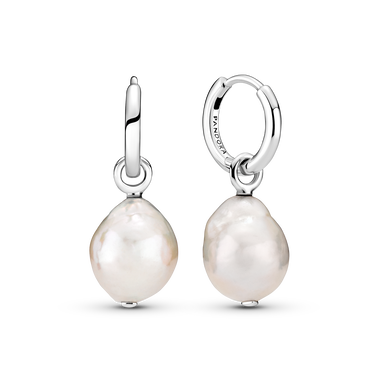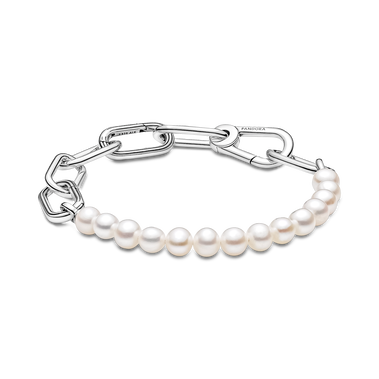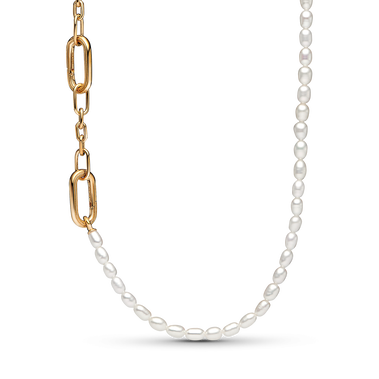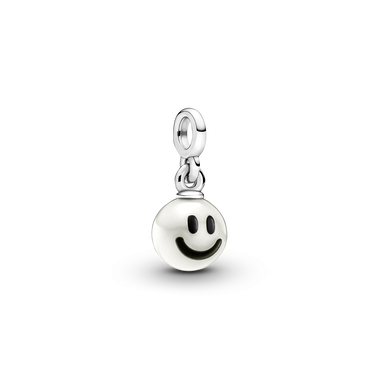Cleopatra. Jackie Kennedy. Audrey Hepburn. What do these famous figures have in common? They’re all known for wearing pearls. Belonging to a small group of precious, natural stones classified as organic gems, pearls have fascinated us for centuries with their mysterious beauty. Their enduring appeal makes them shine in a wide array of jewellery styles, from elegant classics to fresh, modern pieces.
Eyeing a new pearl piece for your jewellery collection, or looking for an extra-special gift? Our complete pearl guide is here to help. We’ll talk you through the different pearl types, jewellery options and how to care for pearls.
Pandora’s two types of natural pearls
Pandora natural pearl jewellery is either made from mother of pearl or treated freshwater cultured pearls. We also use lacquered artificial pearls in some jewellery styles – a laboratory-made glass ceramic that comes with a pearl-like coating.
Let’s take a closer look at what makes our natural pearl materials so special.
What is mother of pearl?
Monther of pearl (or nacre) is not an actual pearl, but the pearly inner layer found within certain mollusc shells.
How is mother of pearl made?
Mother of pearl is composed of calcium carbonate and is a protective layer created by the mollusc to defend itself from parasites.
Once the mother of pearl is cut from the shell of the mollusc, it may be treated with bleach to achieve a uniform white tone or dyed an attractive colour.

What are freshwater pearls?
Freshwater cultured pearls are organic stones that are formed in the pearl sac of a mollusc, with a helping hand from humans. The pearls Pandora uses are treated after harvesting to enhance their colour by bleaching or dying, then perfected with a lustre-enhancing treatment.

How are freshwater cultured pearls made?
Freshwater cultured pearls are produced inside oysters or other molluscs. The pearl farmer starts the process by carefully inserting an irritant inside the shell. The mollusc then starts to cover it with multiple layers of nacre until it’s completely enclosed and creates a pearl.
Our favourite pearl facts
How to wear freshwater pearls
The versatility of pearl jewellery means there’s a way to style them for any occasion. Whether you need an everyday jewellery combination or you’re heading to a wedding, pearls are the answer. Here are our favourite pearl styling tips:

The layered look
Fully embrace the pearl look by layering different designs. You could stack pearl bracelets or wear necklaces in varying lengths.

Minimal pearls
Nail everyday style by wearing sterling silver pieces that subtly integrate pearls, like pearl earrings.

A dark wardrobe
There’s a reason why a classic pearl outfit is based around black clothing. White or ivory pearls pop against dark colours, highlighting their natural beauty.
How to judge pearl quality
The value of a pearl is affected by six factors:
1 Lustre
2 Blemishes
3 Shape
4 Colour
5 Size
6 Matching

Pandora pearl jewellery
Pandora pearl jewellery is crafted with care, creating timeless pieces you’ll wear on repeat. Treat yourself to pearl drop earrings or surprise that special someone with a pearl necklace.
Whether mother of pearl or freshwater, find pearl jewellery that matches your personal style. Create a fresh, cool-toned look with sterling silver, or choose 14k gold-plated pieces for a warm, sophisticated glow.
Pandora pearl jewellery sets
Show your appreciation with pearl jewellery sets. Whether you’re looking for a wedding or anniversary gift(or a special surprise, just because!), our sets offer a complete jewellery look.
How to care for pearls
As a natural stone, pearls deserve to be treated with care. Never soak your pearls in water or rub them harshly, as this could damage the nacre. Instead, clean them with a soft cloth dampened in clean, lukewarm water, then pat dry.
Keep your pearls away from acids, solvents, ultrasonic cleaning, high temperatures or prolonged direct light, as these can damage them.
Keep your pearls looking perfect
As well as the above care tips, make sure you put your pearl jewellery on last, after any cosmetics or perfume. Your skin’s natural oils and moisture also help prevent pearls from drying out – so wearing them is a great way to keep them looking their best! Follow our easy cleaning guide for more expert guidance.
From freshwater to mother of pearl, these pieces add a premium edge to your looks. Keep an eye on our latest jewellery releases by viewing our “new in” selection.




